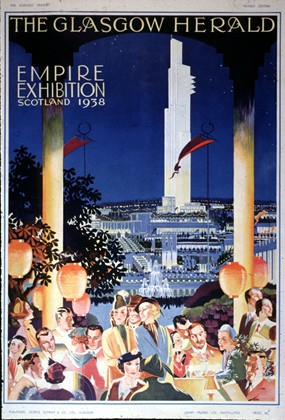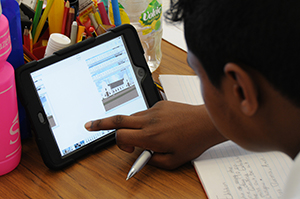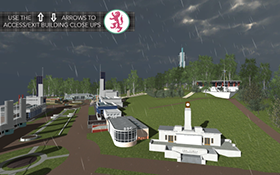British Empire Exhibition 1938 research projects
The 1938 British Empire Exhibition was a stunning display of architectural achievement and a reflection of the life and culture of Glasgow, the UK and the Commonwealth. The event was of huge international significance and continues to be relevant to the study of British social and industrial history and modernist architecture. The School of Simulation and Visualisation (formerly Digital Design Studio) at Glasgow School of Art has been involved in research relating to this exhibition for over ten years.
British Empire Exhibition, Glasgow 1938 project (2004-2006, AHRC-funded)
In 2006, the British Empire Exhibition, Glasgow 1938 project produced a well-researched and constructed, photo-real, 3D model of the over 100 principal buildings and structures that comprised the Exhibition together with an accurate 3D map showing the relationship of the various buildings, road and pathways and water features, to the topography of Bellahouston Park. This project also created an archive of related cultural assets and video interviews recording opinions of experts in the fields of architecture and architectural history as well as the recollections of members of the public who attended the Exhibition in 1938.
The website from this project, www.empireexhibition.com, includes an interactive map of the exhibition, a selection of the digital archive material, video interviews, and text with further information and insight into the Exhibition. There are also a selection of video flythroughs of the 3D model produced by this research available at youtube.
Publications and impacts associated with this project:
- Ian Johnston (Ed.) (2008) Glasgow’s Greatest Exhibition: Recreating the 1938 Empire Exhibition (RIAS, Edinburgh)
- Johnston, I. & Pritchard, Douglas (2007) “Recreating the 1938 British Empire Exhibition” in Proceedings of IEEE VAST 2007: 8th International Symposium on Virtual Reality, Archaeology and Cultural Heritage, (Archaeolingua, Budapest) pp. 85-89.
- The British Empire Exhibition project generated huge public interest with coverage from the BBC (Dec 2007), The Herald (Jan 2006), the Evening Times (May 2007, Dec 2007), and Building Design (May 2008).
- The project led directly to two further AHRC grants: a small grant under the Knowledge Catalyst Scheme: “Marketing the 1938 British Empire Exhibition” which developed a book, teaching materials, postcards and souvenirs to be sold at House for an Art Lover, and delivering a well-attended conference on the previous project and its outputs; and a large grant (£140k) under the AHRC Digital Equipment and Database Enhancement for Impact scheme entitled “Enhancing Engagement with 3D Heritage Data through Semantic Annotation” (see below).

Digitised archive image from the Empire Exhibition, 1938.
REVISIT (2015-2016, AHRC-funded)
The primary aims of this project, Research Engagement through Virtual Immersive Tools for Learning (REVISIT) were to transform the results of The British Empire Exhibition, Glasgow 1938 into innovative learning tools which are specifically targeted to school-age learners in terms of both age and curriculum, to make these learning tools as widely accessible as possible, and to increase our understanding of the impact of immersive learning tools for teachers and learners through a pilot study.
Further details are available from the REVISIT website.
Publications associated with this project:
- In process...

Child interacting with 3D model of the Empire Exhibition, 2016
Enhancing Engagement with 3D Heritage Data through Semantic Annotation (2010-2011, AHRC-funded)
In February 2010, the Digital Design Studio was successful in winning additional AHRC funding to enhance engagement with this remarkable resource through a new project entitled “Enhancing Engagement with 3D Heritage Data through Semantic Annotation”. The purpose of this project was to combine the experience gained through “The British Empire Exhibition, Glasgow 1938” with the Digital Design Studio’s considerable expertise in digital documentation and an exceptionally unique real-time visualisation facility in order to enhance access to and engagement with the data gathered for the British Empire Exhibition project and provide an extensible toolkit for researchers to use with other 3D datasets. The project aimed to improve interpretation of the Exhibition by linking, in a meaningful way, the related cultural artefacts on which the 3D model was based with the modelled data itself. In order to achieve this linkage between the 3D data and related information, the Digital Design Studio developed a tool which allows users to ‘annotate’ the data, and attach those annotations (or files) to points of space within the virtual model, as well as adding relationships between different attached objects (for example, adding notes to architectural features or linking all the photographs taken by a particular photographer). The database of annotations is export-compatible with CIDOC-CRM.
The Enhancing Engagement with 3D Heritage Data through Semantic Annotation project was graded by the AHRC as “An outstanding proposal meeting world-class standards of scholarship, originality, quality and significance”. It allows both researchers and the general public to virtually experience and collaboratively annotate environments which are inaccessible either because they no longer exist or because they are too far away or dangerous to access as well as increasing our understanding of the outstanding achievement of the historic 1938 British Empire Exhibition.
A full .exe of this version of the 3D model and its associated archive can be downloaded from http://ddsgsa.net/projects/empire/Empire/Downloads.html.
Publications associated with this project:
- Abbott, Daisy, Bale, Kim, Gowigati, Ramy, Pritchard, Douglas and Chapman, Paul (2011) Linking Evidence with Heritage Visualization Using a Large Scale Collaborative Interface. Proceedings of the 12th International Symposium on Virtual Reality, Archaeology and Cultural Heritage (VAST 2011). pp. 121-128. ISSN 1811-864x
- Abbott, Daisy, Bale, Kim, Gowigati, Ramy, Pritchard, Douglas and Chapman, Paul (2011) Empire 3D: A Collaborative Semantic Annotation Tool for Virtual Environments. Proceedings of the 8th International Conference on Modelling, Simulation and Visualization Methods, WORLDCOMP 2011.. pp. 121-128.

Mobile interaction with semantically-annotated 3D scenes - 2011
Another View of the Empire (2015, master's project)
Master's student Alexander McRoberts created an “Interactive Heritage Environment”, based on part of the 1938 Glasgow Empire Exhibition held in Bellahouston Park in the south side of Glasgow, namely “the Scottish Avenue”. The visualisations were developed as a research tool. The environment allows users to explore the Scottish Avenue as it was in 1938 and access a selection of contextual information, furthering both the users’ knowledge and understanding of an important part of Glasgow’s history. Two versions of the environment have been developed, both focusing on a different control method. More information and a copy of the resulting thesis is available at: https://anotherviewoftheempire.wordpress.com/.
Publications associated with this project:

Screenshot from the interactive visualisation, 2015